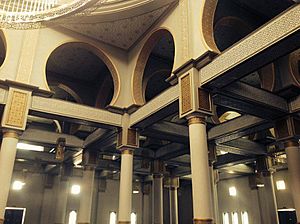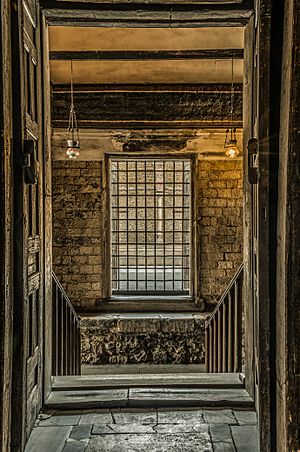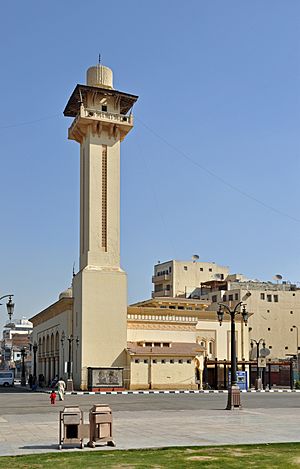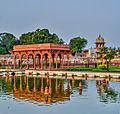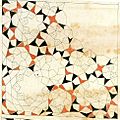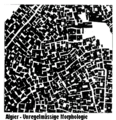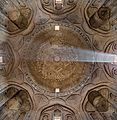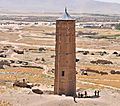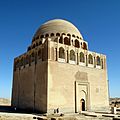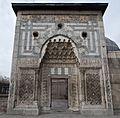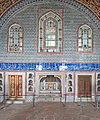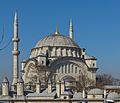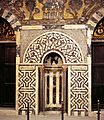Islamic architecture facts for kids
Islamic architecture is the entire range of architecture that has evolved from Islam as a social, cultural, political and religious phenomenon. Hence the term encompasses religious buildings as well as secular ones, historic as well as modern expressions and the production of all places that have come under the varying levels of Islamic influence.
Contents
Classification of Islamic architecture
Islamic architecture can be classified according to
- Chronology
- Geography
- Building Typology
Elements of Islamic style
Islamic architecture may be identified with the following design elements:
- large domes
- minarets (towers)
- large courtyards often merged with a central prayer hall
- the use of iwans to intermediate between different sections
- use of geometric shapes and repetitive art (arabesque)
- extensive use of decorative Arabic calligraphy
- use of symmetry
- ablution fountains
- a mihrab inside mosques indicating the direction to Mecca
- use of bright color
- focus on the interior space of a building rather than the exterior
Influences
A specifically Islamic architectural style developed soon after the Prophet Muhammad. From the beginning the style grew from Roman, Egyptian, Persian/Sassanid, and Byzantine styles. An early example may be identified as early as AD 691 with the completion of Qubbat al-Sakhrah (Dome of the Rock) in Jerusalem. It featured interior vaulted spaces, a circular dome, and the use of stylized repeating decorative patterns (arabesque).
The Great Mosque of Samarra in Iraq, completed in AD 847, combined the hypostyle architecture of rows of columns supporting a flat base above which a huge spiralling minaret was constructed.
Moorish Architecture
Construction of the Great Mosque at Cordoba beginning in AD 785 marks the beginning of Islamic architecture in Spain and Northern Africa (see Moors). The mosque is noted for its striking interior arches. Moorish architecture reached its peak with the construction of the Alhambra, the magnificent palace/fortress of Granada, with its open and breezy interior spaces adorned in red, blue, and gold. The walls are decorated with stylize foliage motifs, Arabic inscriptions, and arabesque design work, with walls covered in glazed tiles.
Timurid Architecture
Timurid architecture is the pinnacle of Islamic art in Central Asia. Spectacular and stately edifices erected by Timur and his successors in Samarkand and Herat helped to dessiminate influence of the Ilkhanid art in India, thus giving rise to the celebrated Moghol school of architecture. Timurid architecture started with the sanctuary of Ahmed Yasawi in present-day Kazakhstan and culminated in Tumir's mausoleum Gur-e Amir in Samarkand. Axial symmetry is characteristic of all major Timurid structures, notably the Shah-e Zendah in Samarkand and the mosque of Gowhar Shad in Meshed. The double domes of various shapes abound, and the outsides are perfused and brilliantly colored.
Ottoman Architecture
The architecture of the Ottoman Empire forms a distinctive whole, especially the great mosques by and in the style of Sinan, like the mid-16th century Suleiman Mosque. The 17th-century Sultan Ahmed Mosque shows the brilliant adaptation and development of the forms established at Hagia Sophia a millennium earlier.
Mughal Architecture
Another distinctive sub-style is the architecture of the Mughal Empire in India in the 16th century. Blending Islamic and Hindu elements, the emperor Akbar constructed the royal city of Fatehpur Sikri, located 26 miles west of Agra, in the late 1500s.
The most famous example of Mughal architecture is the Taj Mahal, the "teardrop on eternity", completed in 1648 by the emperor Shah Jahan in memory of his wife Mumtaz Mahal who died while giving birth to their 14th child. The extensive use of precious and semiprecious stones as inlay and the vast quantity of white marble required nearly bankrupted the empire. The Taj Mahal is completely symmetric other than the sarcophagus of Shah Jahan which is placed off center in the crypt room below the main floor. This symmetry extended to the building of an entire mirror mosque in red sandstone to complement the Mecca-facing mosque place to the west of the main structure.
Persian Architecture
One of the first civilizations that Islam came into contact with during and after its birth was that of Persia. The eastern banks of the Tigris and Euphrates was where the capital of the Persian empire lay during the 7th century. Hence the proximity often led to Islamic architects of early Islam to borrow, but in fact inherit the traditions and ways of the fallen Persian empire.
Islamic architecture in fact borrowed heavily from Persian architecture. Baghdad, for example, was based on Persian precedents such as Firouzabad in Persia. In fact, it is now known that the two designers who were hired by al-Mansur to plan the city's design were Naubakht, a former Persian Zoroastrian, and Mashallah, a former Jew from Khorasan, Iran.
The Great Mosque of Samarra is another example, where the spiral edifice was based on Persian architecture, such as the spiral tower in the middle of Firouzabad, a former Sassanid capital.
Images for kids
-
The Mosque of the Prophet, standing on the site of Muhammad's first mosque in Medina. The present-day building is the result of many reconstructions and expansions up to modern times.
-
Section of the Umayyad-era Mshatta Facade, now in the Pergamon Museum in Berlin, from a palace near Amman
-
The Dome of the Rock in Jerusalem (late 7th century)
-
The Bibi-Heybat Mosque in Baku, Azerbaijan
-
The Bāb al-Yaman (بَـاب ٱلْـيَـمَـن, Gate of the Yemen) in the Old City of Sana'a, Yemen
-
Almnara Tower Somalia
-
The 13th century Fakr ad-Din Mosque in Mogadishu
-
Sultan Qaboos Grand Mosque at Muscat is the main mosque in the Sultanate of Oman, started in 1995 and inaugurated in 2001.
-
Faisal Mosque at Islamabad, Pakistan designed by Vedat Dalokay.
-
Dome with squinches in the Palace of Ardashir of pre-Islamic Persia. Squinches are one of the most significant Sasanian contribution to Islamic architecture.
-
The dome of the Gur-i Amir Mausoleum in Samarqand
-
VIew of the main dome at Humayun's Tomb in Delhi
-
The bulbous domes of the Badshahi Mosque in Lahore
-
The interior of the main dome of Shahi Hammam in Lahore
-
Central domes of the Hagia Sophia
-
Hünkâr Mahfili (prayer space for the sultan) inside the Hagia Sophia (Turkey)
-
Use of jali screen at Lahore Fort (Pakistan)
-
Muqarnas in the Alhambra
-
The muqarna of a mosque in Bukhara, Uzbekistan
-
Intricate design on the muqarna of Wazir Khan Mosque in Lahore
-
Geometrical tile decoration (zellīj) in the Ben Youssef Madrasa in Marrakesh
-
Bengali Islamic terracotta on a 17th-century mosque in Tangail, Bangladesh
-
Design of ceiling in the Mahabat Khan Mosque in Peshawar
-
Stucco-carved mihrab of Uljaytu at the Jameh Mosque of Isfahan (early 14th century)
-
Mihrab of the Jama Masjid in Delhi (mid-17th century)
-
Ottoman minarets of the Sultan Ahmed Mosque in Istanbul (early 17th century)
-
Minaret at the Jama Masjid in Delhi (mid-17th century)
-
Medina quarter of Fez, Morocco
-
Figure-ground diagram of Algiers
-
Ghaznavid Tower of Mas'ud III near Ghazni (in present-day Afghanistan), from the early 12th century
-
Ribat-i Sharaf caravanserai in Khorasan (northeastern Iran), built in 1114–1115
-
The Kalyan Minaret in Bukhara (in present-day Uzbekistan), built in 1127 as part of a Qarakhanid congregational mosque
-
Mausoleum of Sultan Ahmad Sanjar (c. 1152) in Merv (in present-day Turkmenistan)
-
Minaret of the al-Nuri Mosque in Mosul (before its destruction in 2017), dating from the 12th century
-
Yedi Kardeş Tower in the city walls of Diyarbakir, built by Artuqid sultan Nasir al-Din Mahmud in 1208–1209
-
Mausoleum of Fakhr al-Din Razi or Il-Arslan in Kunya-Urgench, Turkmenistan, late 12th or early 13th century (Khwarazmian Empire period)
-
Hypostyle interior of the Alâeddin Mosque in Konya (12th-13th centuries)
-
Courtyard of the Sultan Han caravanserai, built in 1229 on the road between Aksaray and Konya
-
Interior of the Çifte Minareli Medrese in Erzurum (c. 1250)
-
Döner Kümbet in Kayseri (1276), the tomb of a Seljuk princess
-
Süleymaniye Mosque, Istanbul (16th century), designed by Mimar Sinan
-
One of the chambers of the Topkapı Palace
-
Interior of Sultan Ahmed Mosque, Istanbul (early 17th century)
-
Entrance gates of the Dolmabahçe Palace, Istanbul (19th century)
-
Examples of civil Ottoman architecture in Eskişehir
-
Yalı is a house or mansion constructed along the shores of the Bosphorus near Istanbul
-
Reception Hall of Abd ar-Rahman III at Madinat al-Zahra (10th century, caliphal period)
-
Almoravid Qubba in Marrakesh (early 12th century, Almoravid period)
-
Kutubiyya Mosque in Marrakesh (12th century, Almohad period)
-
Giralda tower in Seville: former Almohad minaret (12th century) converted into a Christian bell tower
-
Kasbah Mosque in Tunis (13th century, Hafsid period)
-
Bou Inania Madrasa in Fes (14th century, Marinid period)
-
The Court of the Lions at the Alhambra, Granada (14th century, Nasrid period)
-
Dome of the Hall of Ambassadors in the Alcazar of Seville (14th century): an example of Mudejar architecture
-
Abu al-Abbas al-Mursi Mosque in Alexandria, built in the 1940s in a neo-Mamluk style
-
The Qutb Minar and Quwwat al-Islam Mosque complex in Delhi, begun in the 1190s and expanded in the 13th to 14th centuries
-
Tomb of Shah Rukn-e-Alam in Multan (circa 1335–1340), built under the Tughluq dynasty
-
The Friday Mosque of Ahmedabad (1423), which prominently combines Islamic and indigenous Indian architectural forms
-
Humayun's Tomb in Delhi, the first fully developed Mughal imperial tomb (1560–1570)
-
Fatehpur Sikri, a palatial complex begun in the 1560s by Akbar
-
Room with fountain in the Muthamman Burj (1628–30), added by Shah Jahan inside the Agra Fort built by Akbar
-
Badshahi Mosque in Lahore (c. 1673–1674)
-
Bibi Ka Maqbara at Aurangabad (1678)
-
The Asfi Mosque of the Bara Imambara complex in Lucknow (c. 1780)
-
Gate of Panembahan Senapati Mosque in Kotagede, Yogyakarta.
-
The Grand Mosque of the Masjid Agung in Central Java, Indonesia, features a multi-layered roof typical of Indonesian mosque architecture.
-
Baiturrahman Grand Mosque, Indonesia, with Mughal and Dutch Colonial influences.
-
The Menara Kudus Mosque employs a Hindu-Buddhist temple-like structure as a minaret
See also
 In Spanish: Arquitectura islámica para niños
In Spanish: Arquitectura islámica para niños




